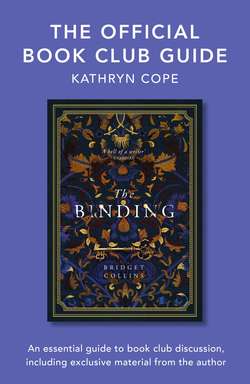Читать книгу The Official Book Club Guide: The Binding - Kathryn Cope - Страница 8
Style
ОглавлениеGENRE
Historical Fantasy
At no point in The Binding does Bridget Collins state when her novel is set. Readers, however, become aware that the author is exploring the realms of the past through little clues, dropped throughout the story. Many of these clues suggest that Collins’s characters are inhabiting nineteenth-century England. Emmett’s family have a mechanical reaping machine (first invented in the 1830s). As a child, Emmett pays for a book in farthings (a currency used in England from 1860-1956). Castleford, with its factories and haze of industrial smog, is clearly a product of the Industrial Revolution, and Hansom cabs (patented in 1834) are a regular form of transport. If characters commit a serious crime, then deportation (a form of criminal punishment used until the mid-nineteenth century) is their likely fate. Clothes are also something of a giveaway, as Alta refers to her restrictive stays, while Lucian’s sister suffers the embarrassment of a creaky corset.
That being said, Collins’s fictional world is not entirely nineteenth-century history as we know it. At times, there are hints that this is an older, almost medieval culture – in the widespread belief in witches and the evocatively pagan-sounding ‘Wakening Fair’. In this era, instead of Christmas, characters celebrate ‘the Turning’, exchanging ye olde world greeting ‘May your darkness be quiet and the light come sooner than you need’.
The novel builds on this sense of a similar, yet alternative history through the revelation of past events which readers will not find reflected in any history book. Although characters refer to the Crusades, it becomes apparent that this is not a reference to the Christian battle for the Middle East which took place in the Middle Ages. In The Binding, the Crusades are a recent historical event and Crusaders fought against books and the magical practice of binding.
Collins’s invention of binding is the most glaring factual twist of all. Although it involves a magical process, binding is represented in the novel as a recognised trade. While characters differ in their opinions of its ethics, no one doubts it exists. Once she has established this ‘fact’, the author goes on to revise the history of literature itself. Not only does the popularity of binding lead to the emergence of fakes (i.e. novels), the British legal system is changed as laws such as ‘The Sale of Memories Act’ are passed in an attempt to regulate the morally dubious areas of the industry. Collins’s introduction of magic into historical fiction follows in the literary footsteps of Susanna Clarke’s Jonathan Strange and Mr Norrell – a novel set during the Napoleon Wars where magic is shown to co-exist with the realities of the everyday world.
Fairy Tale
Classic fairy tales tend to leave a strong imprint on our imaginations, even as adults. Bridget Collins draws upon their mythic resonance by incorporating certain fairy tale tropes into The Binding.
Emmett’s first meeting with Lucian bears many of the elements we might expect from a story by the Brothers Grimm. Returning from poaching, Emmett walks through the woods, loses his sister and, wandering into the ruins of a castle, encounters a man wearing a hooded cloak. Here, in one scenario, we have a whole bundle of images commonly found in fairy tales – a huntsman, a mysterious woodland setting, a disappearance, a castle and, to top it all off, a hooded figure.
As the novel progresses, it seems that the author may have one fairy tale, in particular, in mind. Observant readers may have noticed some, or all, of the following similarities between ‘Sleeping Beauty’ (otherwise known as ‘Briar Rose’) and The Binding: -
The Spell: In ‘Sleeping Beauty’, the heroine is doomed to fulfil a fairy’s spell. On her fifteenth birthday, she pricks her finger on a spindle and falls asleep for one hundred years. When would-be rescuers attempt to save the princess, they are trapped by a hedge of impenetrable brambles shrouding the castle. In Collins’s novel, the process of being bound is like falling under a spell. Living a kind of half-life akin to sleep, Emmett and Lucian are unable to remember each other. Attempts to prompt their memory and reverse this state prove futile.
Roses & Castles: Sleeping Beauty’s real name is Briar Rose, and, in the fairy tale, the image of a wild rose is echoed in the barrier of brambles that grows around her castle. Once one hundred years have passed, these brambles part and bloom into flower, allowing the prince to make his way to the castle (you don’t have to be Sigmund Freud to detect the sexual undertones in this scenario). In The Binding, a rose garden grows in the ruined castle which becomes a magical and intimate meeting place for Emmett and Lucian. At one point, Emmett is pricked by the thorn of a rose in his shirt buttonhole (echoes of the spindle) and Lucian licks away the blood. The rose-entangled ruin is the place where Emmett eventually opens up to Lucian, sexually and emotionally, and accepts who he really is. Images of roses recur throughout the rest of the novel and, when Lucian finally finds his book in Lord Latworthy’s library, it is protected by an iron grille ‘knotted with tendrils and spirals and buds’ - very much like the briar hedge that stands between the prince and Sleeping Beauty.
